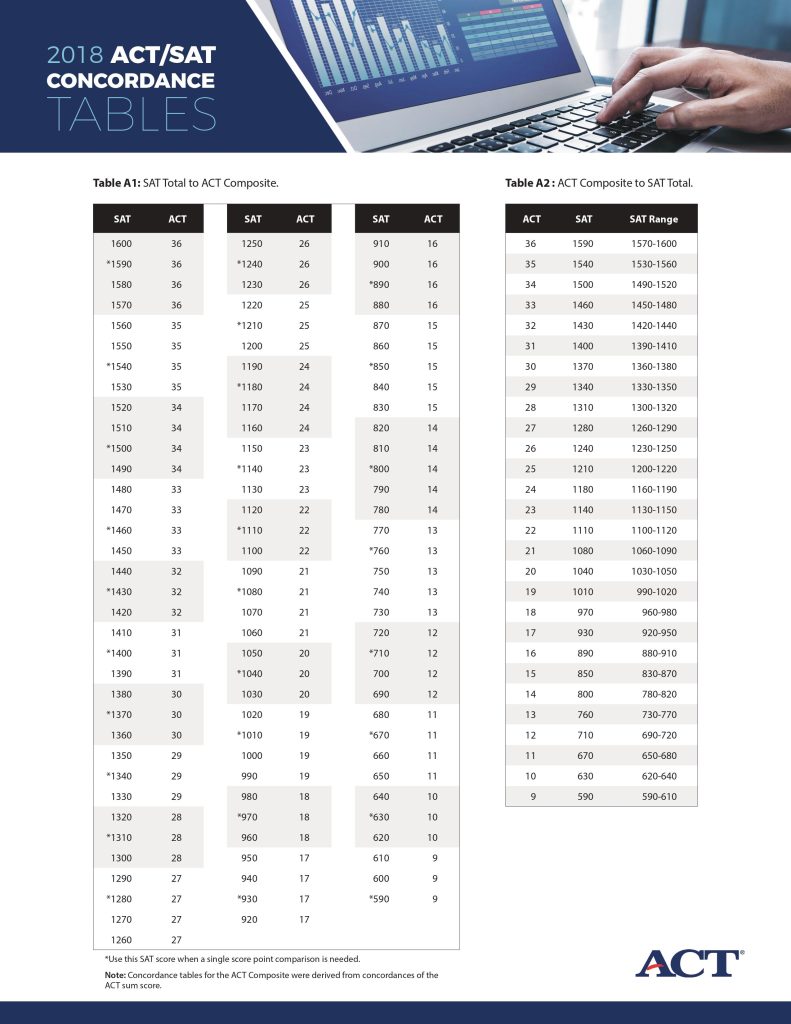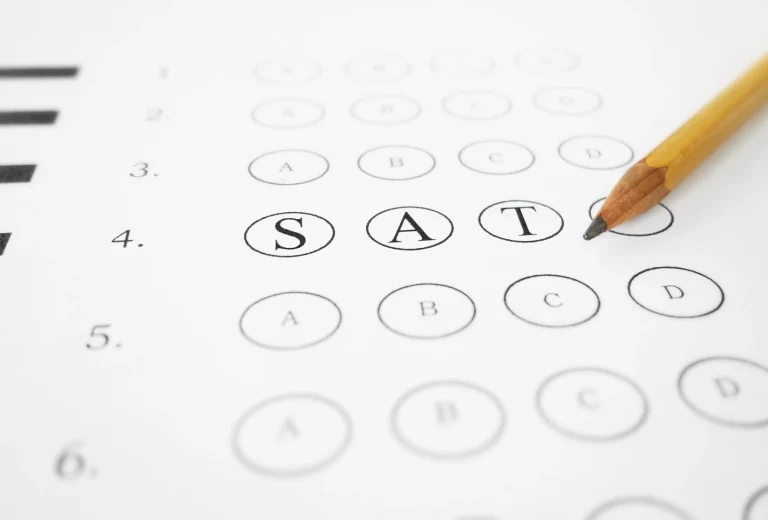1. What is a Superscore?
If you have taken the SAT and ACT, you may have heard of the term “Superscore” mentioned by your teachers or online. For students who are unsure what it means, a Superscore is the average of your best scores from each section across multiple test attempts. In the case of the ACT, this means that it is the average of your best scores from each subject from various tests, while for the SAT it is the average of your best scores from each section across multiple tests. Therefore, your Superscore can never be lower than the lowest score you achieved on a single test. The Superscore ACT policy was released just this year!
Students can take as many SATs as they would like, but only the most recent 6 tests will stay on file at a time. On the other hand, the ACT only allows students to take the test 12 times, though most people will take it 2-3 times.
2. How to calculate your Superscore?
An SAT score is calculated by comparing the Evidence-Based Reading and Writing scores, and Math scores from all test sessions, and taking the highest score from each section to make up one Superscore. If you have taken a test without the essay and another test with the essay, the school will still Superscore your Evidence-Based Reading, Writing, and Math scores across these two versions of the exam.
Let’s start with an example to visualize how a Superscore works:
| Test | Evidence-Based Reading and Writing Section: 200–800 | Math Section: 200–800 | Composite |
| Test 1 | 590 | 500 | 1090 |
| Test 2 | 700 | 480 | 1180 |
| Superscore | 700 | 500 | 1200 |
From this example, student A earned a higher score on the second test in terms of reading and writing (700) and on the first test in terms of math (500). Using the Superscore system, the student earned a total SAT score of 1200, calculated by adding the two best scores together. He can submit this Superscore to eligible colleges for consideration.
The ACT score is calculated by comparing the English, Mathematics, Reading, and Science section results from multiple test sessions, and taking the highest score from each subject across each test date to make up one Superscore.
Here is for ACT scores:
| Test date | English | Math | Reading | Science | Composite |
| April | 19 | 21 | 23 | 21 | 21 |
| June | 22 | 24 | 23 | 21 | 23 |
| September | 20 | 22 | 21 | 21 | 21 |
| Superscore | 22 | 24 | 23 | 21 | 23 |
Both ACT and SAT scores can be calculated by adding the highest score in each section/each subject together. The only difference is that for SAT, you need to add them up for the Superscore, while for the ACT, you have to add the scores together and then divide that number by four (the number of sections). If the result is a decimal (like 22.5), round up to the nearest whole number, and that is your ACT Superscore.
ACT has published a tool to help you calculate your composite and Superscore easily here if you don’t want to do a manual calculation.
3. Superscore and Score Choice
Another term that can be confusing for students is Score Choice™. Score Choice is offered for both the SAT and ACT, and students can decide which SAT scores they want to send or not send to colleges. However, you can’t choose which sections of the test from specific test dates to send; you will have to use your Superscore instead of Score Choice. You can choose to send the April test you took, but not the English and Math April scores and the Reading and Science September test scores. CollegeBoard states, “You can choose which scores to send by test date for the SAT (Score Choice) and by individual test for SAT Subject Tests. Scores from an entire SAT are sent.” This is also true for the ACT.
Most schools allow Score Choice, with a few exceptions. Some schools require you to send all the test scores if you have more than one. Students should double-check with the institutions they are applying for to comply with their testing policies. Here is the list of SAT® Score-Use Practices by Participating Institution if you want to see all possible colleges and universities.
You may ask the reasoning behind the requirement to send all scores. One possible explanation is that schools want to see your development throughout the years for comparison, since your scores include different sub-scores of Analysis in History/Social Studies, Analysis in Science, etc.
4. Understanding your ACT and SAT Scores
SAT
When students first look at the SAT score report, the numbers can be a bit confusing and overwhelming. But, don’t worry; we will walk you through every section and how it’s scored!
Section A: Your Total Score is the sum of two section scores (Evidence-Based Reading and Writing Score AND Math Score), ranging from 400-1600.
Section B: Percentile “represents the percentage of students whose score is equal to or lower than their score,” meaning that if a student’s score is in the 60th percentile, 60% of people achieved at or below that student’s score. Section B contains the National Representative Sample Percentile and SAT User Percentile.
- National Representative Sample Percentile compares your score with all students in 11th and 12th grades.
- SAT User Percentile compares your score with students in the past three graduating classes who took the current SAT in high school.
Section C: On the right side, you will see the green and yellow symbols next to your section scores. Those symbols indicate your “college readiness” and compare your score with a benchmark score. If you reach the benchmark score, you’re ready for college and vice versa. You will also see the benchmark scores for that test date on the right side of your score report. For example, Evidence-Based Reading and Writing: 480 and Math: 530
Section D: Test Scores for three sections Reading, Writing and Language, and Math. The score range for each section is 10-40.
Section E: Cross-Test Scores score students’ answers to selected questions across all three sections. There are two considered domains: Analysis in History/Social Studies and Analysis in Science.
ACT
Looking at the score report, you will see a composite score, which is the average of four
multiple-choice subject test scores, rounded to the nearest whole number: Math, Science, Reading, and Writing.

On your test score report, you will see some rectangles with a thick line, which is your score range. The purple line shows the college readiness benchmark. According to ACT, “If your score is at or above the Benchmark, you have at least a 50% chance of obtaining a B or higher or about a 75% chance of obtaining a C or higher in specific first-year college courses in the corresponding subject area. There is currently no Benchmark for writing.”

In addition, if you took a writing test, it will be graded by two graders on a scale of one to six in each of the domains above. The scores you see above are the totals of the two graders’ scores. Your writing score is the average of four domain scores, rounded to the nearest whole number.

This is the US and States Rank Section for different subject tests. The ranks represent the approximate percentages of recent high school graduates in the US and your state who took the ACT and received scores that are the same as or lower than your scores.
A US rank of 59% means 59% of students earned a Composite score of your score or below.

The last section details your results in each subject and ACT Readiness Range. This range indicates whether students have met the ACT College Readiness Benchmark on the subject test.
Understanding Complex Text is another indicator of performance, measuring your ability to understand college courses with rigorous reading requirements.
5. SAT to ACT and ACT to SAT Score Conversion
Some students prefer converting scores between each exam to compare their performance and create their improvement strategy, or they just want to see whether their scores reflect their hard work.
CollegeBoard has provided us with the calculator tool for score conversion here. If students want to refer to the table, we inserted an image below for easier reference. Because the table was last updated in 2018, some of the numbers may not hold true in 2023; however, it’s a great starting point for students to refer to. Students can refer to the complete guide here for SAT to ACT and SAT conversion at CollegeBoard.

To convert your SAT score to the ACT scale, or the other way around, you’ll need to refer to the official concordance charts produced by the CollegeBoard. These tables provide a handy and up-to-date reference for converting your scores. For the sake of simplicity, we’ve copied the charts below. If you’d like to see them in their entirety, be sure to visit the Guide to the 2018 ACT®/SAT® Concordance.
6. When should you take the SAT and ACT
SAT: In the United States, the SAT is given seven times a year: March, May, June, August, October, November, and December. Most students usually take their first SAT during the spring of their junior year, the second time during late summer, and the third time during the early fall of their senior year. In preparation for college application deadlines, there are three national SAT administration dates in August, October, and November: ED in November/December; EA during January; etc. Students should follow these schedules, as colleges don’t want you to take the SAT too early, even though technically you can take it starting your freshman year and have its score be valid until college applications (SAT and ACT scores are valid for three years, but you can self-report invalid scores).
Colleges asking for all your SAT scores want to see the lowest and highest ones, the time gap between each one, and a score analysis to evaluate your academic performance and growth. In the United States, the SAT is given seven times a year: March, May, June, August, October, November, and December. Many students usually take their first SAT during the spring of their junior year, the second time during late summer, and the third time during the early fall of their senior year. In preparation for college application deadlines, there are three national SAT administration dates in August, October and November: ED in November/December; EA during January; etc. Students should follow these schedules, as colleges don’t prefer that you take the SAT too early, even though technically you can take it starting your freshman year and have its score be valid until college applications (SAT and ACT scores are valid for three years, but you can self-report invalid scores). Colleges asking for all your SAT scores want to see the lowest and highest ones, the time gap between each one, and a score analysis to evaluate your academic performance and growth.
Introducing Aralia Test Preparation Bootcamp, where students can excel in standardized tests with our comprehensive approach. At Aralia, we prioritize maximizing study efficiency and accelerating score improvement through a combination of practice examinations, expert strategies, and personalized guidance. Our Bootcamp offers students the opportunity to achieve significant score improvements within a condensed timeframe by learning strategic approaches tailored to their individual needs. With instructors who are AP readers, students benefit from expert teaching and gain valuable insights into exam techniques. Furthermore, our program equips students with versatile skills and strategies that can be applied to a range of standardized tests, ensuring they are well-prepared to adapt to various exam types.
Further reading:









